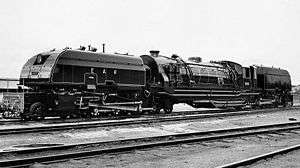EAR 59 class
The EAR 59 class was a class of oil-fired 1,000 mm (3 ft 3 3⁄8 in) gauge Garratt-type articulated steam locomotives. The 34 members of the class were built by Beyer, Peacock & Co. in Manchester, England, for the East African Railways (EAR). They entered service in 1955–56, and were the largest, heaviest and most powerful steam locomotives to operate on any metre gauge railway in the world.[1]
| East African Railways 59 class | |||||||||||||||||||||||||||||||
|---|---|---|---|---|---|---|---|---|---|---|---|---|---|---|---|---|---|---|---|---|---|---|---|---|---|---|---|---|---|---|---|
 5902 prior to being named Ruwenzori Mountains | |||||||||||||||||||||||||||||||
| |||||||||||||||||||||||||||||||
| |||||||||||||||||||||||||||||||
| |||||||||||||||||||||||||||||||
| |||||||||||||||||||||||||||||||
Description
The locomotives had a 4-8-2+2-8-4 wheel arrangement, weighed 252 tons, and delivered a tractive effort of 83,350 lbf (370.76 kN). They were designed to haul 1,200-ton trains on 1.5% gradients and were the mainstay of freight services on the 330-mile run from Mombasa to Nairobi until the late 1970s.
During normal service the locomotives were manned by two regular crews on a 'caboose' basis, one working and one resting in a van with sleeping accommodation, changing over at eight-hour intervals.
The engines, many with Sikh drivers, were kept very clean and the cabs were polished and immaculate. The most famous was 5918 Mount Gelai with a devoted crew known as the 'Magnificent Foursome' who worked her for 16 years. The two drivers, Kirpal Singh and Walter Pinto, simply took their holidays when the locomotive went into the works at Nairobi for scheduled maintenance.
According to railway photographer Colin Garratt (in 1975), 'the overall condition of Mount Gelai is possibly unrivalled anywhere in the world today. Her cab interior is more akin to a Sikh temple than a locomotive footplate for its boiler face abounds in polished brasswork, embellished with mirrors, clocks, silver buckets and a linoleum floor'.[2]
Withdrawal started in 1973 with the last locomotive (Mount Gelai) removed from service in April 1980 when it was driven by its long time driver, Kirpal Singh directly to the railway museum. Mr Singh retired from railway service the same day. Together with Mount Gelai, Mount Shengena was also saved from the scrapyard and both are now preserved by the Nairobi Railway Museum.
In August 2001 Mount Gelai was removed from the Railway Museum and towed to Kenya Railways main works for overhaul to operating condition. Between November 2001 and September 2005 the locomotive made three round trips to Mombasa hauling excursion trains. It was also used on a least one occasion to haul a freight train to Nairobi due to a diesel locomotive shortage. However, it has not operated outside the confines of Nairobi since 2005 and is unlikely to do so again due to operational restrictions and the at least partial replacement of Kenya's meter gauge (1,000 mm (3 ft 3 3⁄8 in)) rail lines with standard gauge (1,435 mm (4 ft 8 1⁄2 in)) lines.
In fiction
In the 2018 Thomas and Friends special Big World! Big Adventures! the new character Kwaku is based on the EAR 59 class.
Names
The locomotives were named after mountains in East Africa:
- 5901 Mount Kenya
- 5902 Ruwenzori Mountains
- 5903 Mount Meru
- 5904 Mount Elgon
- 5905 Mount Muhavura
- 5906 Mount Sattima
- 5907 Mount Kinangop
- 5908 Mount Loolmalasin
- 5909 Mount Mgahinga
- 5910 Mount Hanang
- 5911 Mount Sekerri
- 5912 Mount Oldeani
- 5913 Mount Debasien
- 5914 Mount Londiani
- 5915 Mount Mtorwi
- 5916 Mount Rungwe
- 5917 Mount Kitumbeine
- 5918 Mount Gelai - preserved at Nairobi Railway Museum
- 5919 Mount Lengai
- 5920 Mount Mbeya
- 5921 Mount Nyiru
- 5922 Mount Blackett
- 5923 Mount Longonot
- 5924 Mount Eburu
- 5925 Mount Monduli
- 5926 Mount Kimhandu
- 5927 Mount Tinderet
- 5928 Mount Kilimanjaro
- 5929 Mount Longido
- 5930 Mount Shengena - preserved at Nairobi Railway Museum
- 5931 Ulguru Mountains
- 5932 Ol'donyo Sabuk
- 5933 Mount Suswa
- 5934 Menengai Crater
Notes
- Ramaer 1974, pp. 72–73.
- Garratt, Colin (1974). Steam Safari.
References
- Durrant, A E (1981). Garratt Locomotives of the World (rev. and enl. ed.). Newton Abbot, Devon, UK; North Pomfret, Vt, USA: David & Charles. ISBN 0715376411.
- Durrant, A E; Lewis, C P; Jorgensen, A A (1981). Steam in Africa. London: Hamlyn. ISBN 0600349462.
- Herron, Terry (June 1959). "The largest loco in the world on the metre gauge" (PDF). East African Railways and Harbours Magazine. East African Railways and Harbours. 4 (3): 68. Retrieved 9 December 2014.CS1 maint: ref=harv (link)
- Patience, Kevin (1976). Steam in East Africa: a pictorial history of the railways in East Africa, 1893-1976. Nairobi: Heinemann Educational Books (E.A.) Ltd. OCLC 3781370.
- Ramaer, Roel (1974). Steam Locomotives of the East African Railways. David & Charles Locomotive Studies. Newton Abbot, Devon, UK; North Pomfret, Vt, USA: David & Charles. ISBN 0715364375.
- Ramaer, Roel (2009). Gari la Moshi: Steam Locomotives of the East African Railways. Malmö, Sweden: Stenvalls. ISBN 9789172661721.
- Rule, Sheila (July 16, 1988). "NAIROBI JOURNAL; A Little Engine That Could Still Can". The New York Times. Retrieved 3 November 2014.
- Staff writer (June 1955). ""59" Class Locomotives". East African Railways and Harbours Magazine. East African Railways and Harbours. 2 (3): 89. Retrieved 8 December 2014.CS1 maint: ref=harv (link)
External links
| Wikimedia Commons has media related to EAR 59 class. |